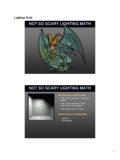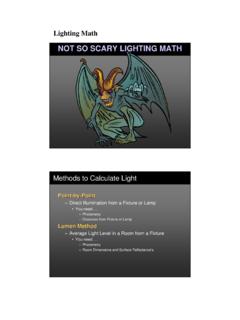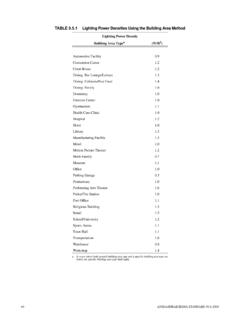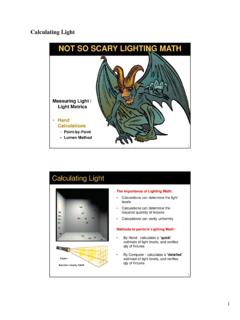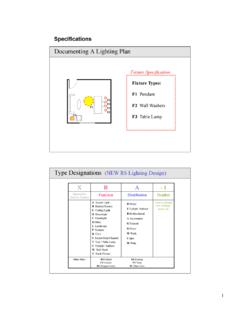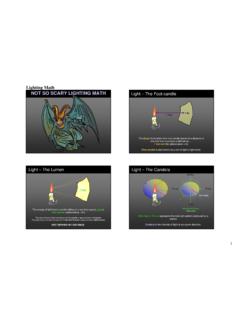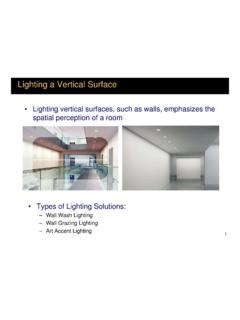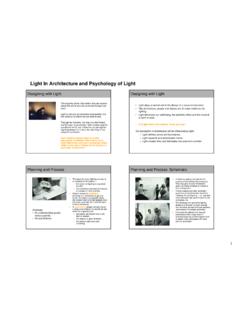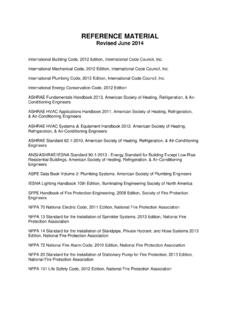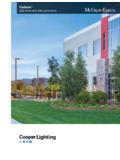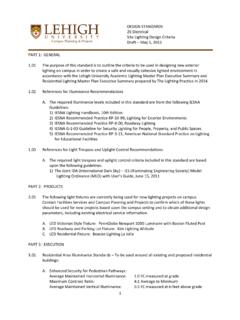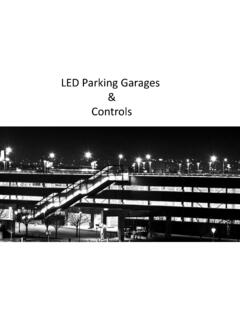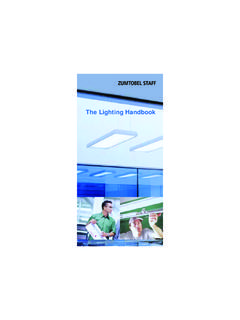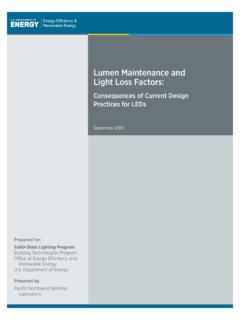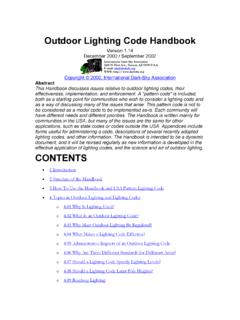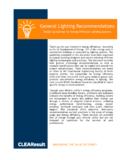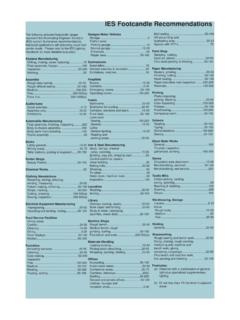Transcription of ILLUMINANCE SELECTION - RS Lighting Design
1 ILLUMINANCE SELECTION In 1979, the IESNA established an ILLUMINANCE SELECTION procedure, which was published in the 6th, 7th, and 8th editions of its Lighting handbook . The philosophy of that procedure was to enable the Lighting designer to select illuminances based on a knowledge of space and occupant characteristics as well as the task and worker characteristics. The philosophy of that procedure has been embraced again in this edition , but the procedure has been modified and simplified to place visual performance and therefore ILLUMINANCE SELECTION more in balance with the other important Lighting Design criteria presented in this chapter and discussed throughout this edition of the IESNA Lighting handbook .
2 Specifically, the recommended illuminances provided in the Design Guide are based on the Society's judgment of best practice for "typical" applications. Every situation is unique so, naturally, typical conditions may not be appropriate for a specific application. As a professional, the Lighting designer should have a better understanding of the particular space and the needs of the occupants and clients than what can be presented in a recommended ILLUMINANCE value for a typical space. ILLUMINANCE Recommendations In 1979, the IESNA established nine ILLUMINANCE categories, "A," the lowest set of recommended illuminances, through "I," the highest set. Each of the nine categories had general descriptions of the visual task, irrespective of the application.
3 Generally, the same approach has been employed in this edition of the IESNA Lighting handbook to help Lighting designers establish the best task ILLUMINANCE . However, four important modifications have been adopted. 1. The recommended illuminances are no longer provided without reference to a specific application. Every application in the Design Guide has a specific recommended ILLUMINANCE (horizontal, vertical, or both) representing best practice for a typical application. 2. The nine ILLUMINANCE SELECTION categories established earlier by the IESNA have been reduced to seven categories and organized into three sets of visual tasks (orientation and simple, common, and special). These groupings provide additional clarity to the category descriptions (Figure 10-9).
4 3. Additional precision has been given to the task descriptions in each category. In the previous three editions it was impossible for the Lighting designer to unambiguously ascertain what constituted, for example, "low contrast" or "small size." Specific ranges of contrast and size have been established for this edition (Figures 10-10 and 10-11). 4. Recommended illuminances increase roughly logarithmically with increasing task difficulty by combined changes in task contrast and task size, as defined in Figure 10-10. These recommendations are guided by both the scientific literature and practical experience. Figure 10-9. Determination of ILLUMINANCE Categories* Page 17 of 30 Quality of the Visual EnvironmentIESNA Lighting Design GuideInterior-1I.
5 INTERIOR Very Important Somewhat important Blank = Not important or not applicableLOCATIONS AND TASKSD esign IssuesAppearance of Space and LuminairesColor Appearance (and Color Contrast)Daylighting Integration and ControlDirect GlareFlicker (and Strobe)Light Distribution on SurfacesLight Distribution on Task Plane (Uniformity)Luminances of Room SurfacesModeling of Faces or ObjectsPoint(s) of InterestReflected GlareShadowsSource/Task/Eye GeometrySparkle/Desirable Reflected HighlightsSurface Characteristics System Control and FlexibilitySpecial ConsiderationsNotes on Special ConsiderationsIlluminance (Horizontal)Category or Value (lux) ILLUMINANCE (Vertical)Category or Value (lux)Notes on ILLUMINANCE - see end of sectionReference Chapter(s)Ch.
6 11Ch. 23CA Ch. 14C BACh. 11(1)CA(1)DA(1)EA(1)AC(1)AB (2)DACA (3) ATM facilities writing surface ATM facilities surrounding area Writing area Tellers' stations ATM facilities keypad ATM facilities display screenBanks (see Reading) Lobby GeneralAuditoriums Assembly Social activityImportantAccounting (see Offices)Air Terminals (see Transportation Terminals in Section V, Transportation)ArmoriesArt Galleries (see Museums)Interior-1 IESNA Lighting Design GuideInterior-2 EDCh. 13 DBCABAD(1)CD(1)CBEA(1)CD(1)CC(1)CAE(1)CD (1)CDA(1)CBCACh. 14 DCh. 11DB(1)ED(see Houses of Worship section) Critical seeing (refer to task) Video conference Lounge and readingConference Rooms MeetingChurches and Synagogues Club and Lodge Rooms Sport and race books General Game surface Video and slots Game surface Roulette General Game surface General Game surface Poker General Craps General Game surface Keno Game surface Blackjack General Game surface General Game surface Bingo General High activity Medium activity Low activity BaccaratBarber Shops/SalonsCasino and Gaming CirculationInterior-2 IESNA Lighting Design GuideInterior-3I.
7 INTERIOR Very Important Important Somewhat important Blank = Not important or not applicableLOCATIONS AND TASKSD esign IssuesAppearance of Space and LuminairesColor Appearance (and Color Contrast)Daylighting Integration and ControlDirect GlareFlicker (and Strobe)Light Distribution on SurfacesLight Distribution on Task Plane (Uniformity)Luminances of Room SurfacesModeling of Faces or ObjectsPoint(s) of InterestReflected GlareShadowsSource/Task/Eye GeometrySparkle/Desirable Reflected HighlightsSurface Characteristics System Control and FlexibilitySpecial ConsiderationsNotes on Special ConsiderationsIlluminance (Horizontal)Category or Value (lux) ILLUMINANCE (Vertical)Category or Value (lux)Notes on ILLUMINANCE - see end of sectionReference Chapter(s)Ch.
8 14DB (4)DBCh. 14CA(1)EC (5)(1)EC (6)(1)EC (5)(1)DBAABACh. 23 CADAD epots, Terminals, Stations (see Transportation Terminals in Section V, Transportation)Drafting/Graphic Arts CAD stations only Mixed CAD and paper taskDance Halls/Discotheques Dance halls/discotheques Ballrooms/social events Litigant's table Podium Witness chairCourt Rooms (see Reading) Seating area (spectators) Judge and clerk Cells Day roomsCorridors (see Service Spaces)Correctional FacilitiesInterior-3 IESNA Lighting Design GuideInterior-4 ECFDECFD(7)CAECCh. 12 CEDEDFEFECh. 20 FDBACh. 20Ch. 13Ch. 18 BBACh. 29CA Dormitories (see Residences)Elevators, Freight Study halls (see Reading) Typing (see Reading) GymnasiumsExhibition HallsEmergency Lighting (see Section VI, Emergency, Safety, and Security)Elevators, Passenger Other sports (See Section IV, Sports) Social events Outdoor sports facilities (see Section IV, Sports) Cafeterias (see Food Service Facilities) Basketball Demonstration Music rooms (see Reading) Shops (see Section II, Industrial) Sight saving rooms Home economics (see Residences) Science laboratories Lecture halls Audience (see Reading) Classrooms General (see Reading) Art rooms Drafting (see Drafting/Graphic Arts)
9 PrintsEducational Facilities Corridors High contrast Low contrast Overlays Light table Mylar High contrast media Low contrast media Vellum/mylarInterior-4 IESNA Lighting Design GuideInterior-5I. INTERIOR Very Important Important Somewhat important Blank = Not important or not applicableLOCATIONS AND TASKSD esign IssuesAppearance of Space and LuminairesColor Appearance (and Color Contrast)Daylighting Integration and ControlDirect GlareFlicker (and Strobe)Light Distribution on SurfacesLight Distribution on Task Plane (Uniformity)Luminances of Room SurfacesModeling of Faces or ObjectsPoint(s) of InterestReflected GlareShadowsSource/Task/Eye GeometrySparkle/Desirable Reflected HighlightsSurface Characteristics System Control and FlexibilitySpecial ConsiderationsNotes on Special ConsiderationsIlluminance (Horizontal)Category or Value (lux) ILLUMINANCE (Vertical)Category or Value (lux)
10 Notes on ILLUMINANCE - see end of sectionReference Chapter(s)Ch. 11Ch. 11Ch. 11Ch. 13 ECDACCAE(8)BABAECEADACECDA Pantry Refuse area Sculleries Thaw room Nonrefrigerated Refrigerated Galley Kitchen Dining Cashier Food displays Food storage Fire Stations (see Municipal Buildings - Police and Fire) Butcher shop CleaningFood Service Facilities (If equipment locations are known, see Residences-Kitchens)Filing (see Offices and Reading)Financial Facilities (see Banks)Interior-5 IESNA Lighting Design GuideInterior-6(9)DACh. 13Ch. 22Ch. 17 FDFDECFDFDECCh. 16(10)EC(10)EC(10)EC(10)GE(10)DB(10)ECEC FDDBDBCABAEA(10)BA(10)EC(10)(11)(10)F(10 )EC(10)DBECGE Instrument tray Oral cavity Handwashing Cystoscopy room Dental suite General Critical care areas General Examination Surgical task Lighting Nursing areas, day Nursing areas, night Operating areas, delivery, recovery, and laboratory suite and service Inspection Work areas, general Processed storage Corridors Morgue, general Cardiac function laboratory Central sterile supply Inspection, general Anesthetizing Autopsy and morgue Autopsy, general Autopsy table Photographs, moderate detailHealth Care Facilities Ambulance (local)
